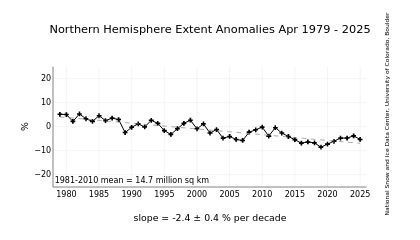Ice Loss and Global Warming
The loss of ice worldwide is a strong indicator that something is wrong with our climate. Any trend is has its ups and downs and global temperatures while clearly increasing contains enough complications to generate a lot of discussion. But sea and land ice are very clear and the global warming deniers as a result avoid discussing their loss. For example, Arctic sea ice is dramatically declining:

As a Congressman so famously pointed out, melting floating ice has no implications for sea level rise. Though he fails to mention that the loss of sea ice is still disturbing evidence of something going wrong with our climate.
The loss of land ice on the other hand does have implications for anyone living near an ocean.
The total global ice mass lost from Greenland, Antarctica and Earth's glaciers and ice caps during the study period was about 4.3 trillion tons (1,000 cubic miles), adding about 0.5 inches (12 millimeters) to global sea level. That's enough ice to cover the United States 1.5 feet (0.5 meters) deep.
A half inch increase in sea level doesn't sound like much, but just wait: Antarctic and Greenland are losing billions of metric tons of ice per year.

That's 421 billion tons a year. That's 12.6 trillion tons in thirty years for a three feet increase in sea level. Any bank offering a 30 year loan today on ocean front property will be in serious financial trouble in thirty years.
Actually that's a minimum estimate. Those curves display some nonlinearity suggesting an acceleration in the decline of land ice. In other words, it'll be a lot more than three feet in thirty years. More like three feet in twenty years.
And this is no better proof of how much trouble we're in how much ever people want to quibble about the rise in global temperatures.


Comments
Post a Comment